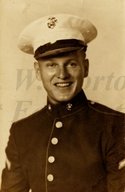
|

|
|
|
|
Clem, as he is called, was born at home in Orange, Texas to Largent Henderson and Doris Duhon Henderson. His father, a veteran of World War I, was employed in a construction company building railroad boxcars, as well as in the oil fields. He often worked "seven days a week, twelve hours a day," as Clem recalls. The family ate vegetables from its garden, as well as chickens and turkeys and other meat, usually pork, preserved in a smokehouse. His mother canned, cooked on a wood stove and cooled foods in an icebox. A Model T Ford was the family car, but Clem occasionally rode his horse, Rexella, to school. Because his father's worked in the oil fields, the family moved often, including stays in Victoria, Texas and Morgan City, Louisiana. Clem delivered magazines such as The Saturday Evening Post and The Liberty. He hunted and fished to supplement the family table. A football player, his team at Jennings High School in Jennings, Louisiana won the state championship in 1939. After graduating from high school in 1941 he entered Louisiana Tech on a football scholarship. Clem tried to join the U.S. Army Air Forces as well as the U.S. Army but was turned down because of a hearing problem. The U.S. Marine Corps accepted him, however, and he entered service on June 18, 1943. After boot camp in San Diego Clem finished high-speed radio school. At Camp Lejeune in North Carolina he learned cryptograms in breaking down Japanese codes. Assigned to the 2nd Joint Assault Signal Company (JASCO), Clem sailed from San Diego to Saipan, finally reaching the island after a thirty-eight-day trip in September of 1944. The only food served on the voyage, he recalls, was potato soup and beans. At Saipan 2nd JASCO handled communications for ship-to-shore as well as for amphibious landings and air support. On several nights the alarm sounded for as many as five Japanese air raids. As part of the 2nd Division, Clem left Saipan on the USS Hendry (APA 118) to participate in the diversionary "landing" at Okinawa on Easter Sunday, April 1, 1945. Afterward, while waiting out at sea, the men aboard the ship learned that President Franklin Roosevelt had died. After the division was returned to Saipan, he was placed in the 8th Marine Regiment and sent to Okinawa in the final stages of the battle. Clem rode aboard LST 895 and helped take the neighboring island of Ie Shima on June 3, 1945. He remained there while an airfield was built. "I worked seventy-two straight hours during the invasion, because I was manning the telephone switchboard," he recalls of the battle at Ie Shima. On June 14 he went aboard LST 520 and helped in the final operations on Okinawa. Returning to Saipan, Clem was transferred to Headquarters Company, 3rd Battalion 10th Marine Regiment and was preparing for the invasion of Japan when the atomic bombs were dropped. During the occupation of Japan, Clem played for a division football team. He left the country in April of 1946. The day he got home he went to work at midnight on a drilling rig for Humble Oil. Returning to Louisiana Tech in the fall of 1946, he used both an athletic scholarship and the GI Bill to earn his bachelor's and master's degrees. After graduating in 1948 he was hired by Caddo Parish School System, where he spent twenty-nine years, serving as a coach, teacher, and principal at Fair Park High School. On September 26, 1963 he married Martha Vines. (They would have three sons, Clem, Jr., Charles, and Jim.) He retired in June of 1977. The couple moved to Arkansas where Martha worked at John Brown University, and Clem served as president of the PTA and of the booster club "and anything else that kids needed." |


